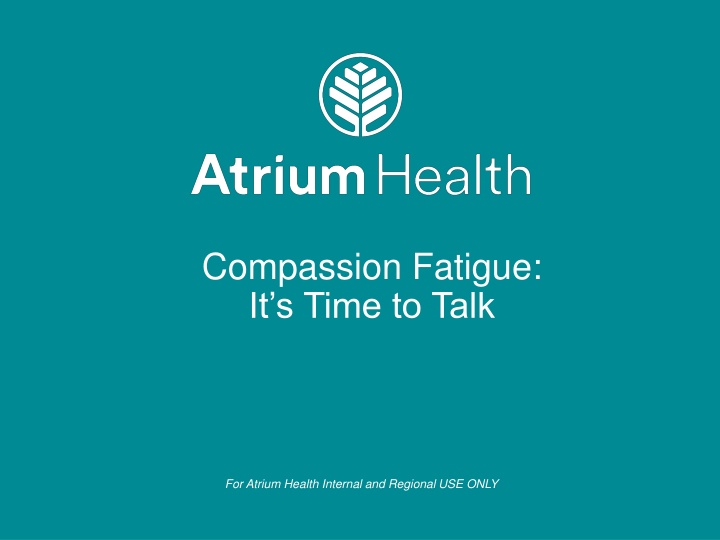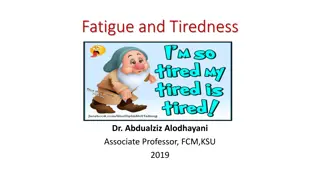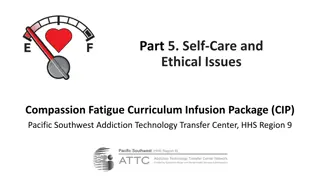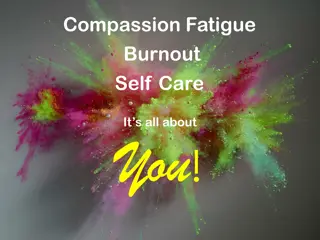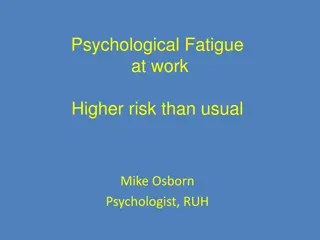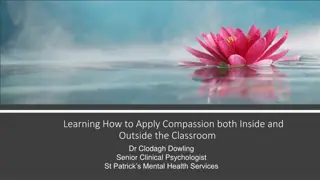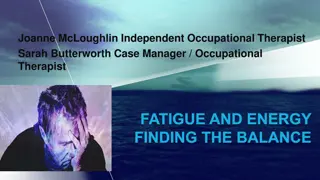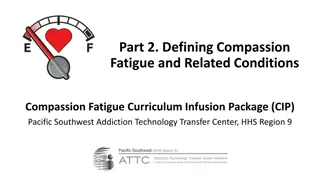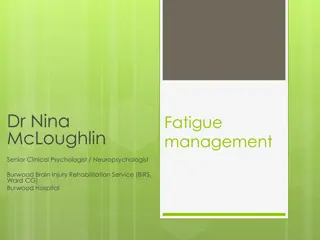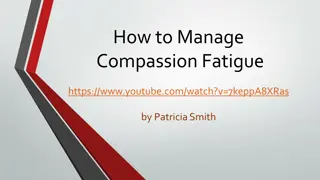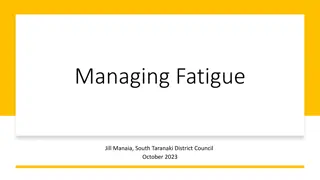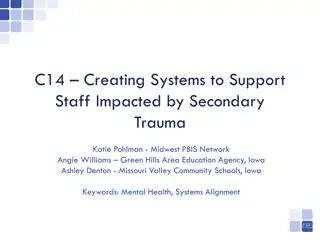Compassion Fatigue:
Compassion fatigue is a state of tension and stress resulting from caring for traumatized individuals. It can lead to decreased compassion, negative attitudes, and various symptoms affecting mental health and well-being. Recognizing the signs, causes, and impact of compassion fatigue is essential for those in caregiving roles to seek support and prevent burnout.
Download Presentation

Please find below an Image/Link to download the presentation.
The content on the website is provided AS IS for your information and personal use only. It may not be sold, licensed, or shared on other websites without obtaining consent from the author.If you encounter any issues during the download, it is possible that the publisher has removed the file from their server.
You are allowed to download the files provided on this website for personal or commercial use, subject to the condition that they are used lawfully. All files are the property of their respective owners.
The content on the website is provided AS IS for your information and personal use only. It may not be sold, licensed, or shared on other websites without obtaining consent from the author.
E N D
Presentation Transcript
Compassion Fatigue: It s Time to Talk For Atrium Health Internal and Regional USE ONLY
Definition A state of tension, stress, and/or preoccupation with an individual or cumulative trauma of patients which is manifested in one or more ways including re-experiencing the traumatic event, avoidance or numbing of reminders of the event, and persistent stress. It is the natural consequence of stress resulting from caring for and helping traumatized or suffering people or animals.
A Further Definition Compassion Fatigue is also known as secondary traumatic stress (STS). When we put our compassionate hearts out for others along with our skills and have them stepped on or spat upon, there will be a gradual lessening of compassion over time. Our hearts withdraw understandably. Compassion Fatigue also occurs when we have a strong identification with the one suffering and/or going through trauma. Empathy combined with a perceived sense that it is impossible to affect positive change can result in negative attitudes and increasing lack of caring.
Symptoms Hopelessness/Despair Decrease of pleasure Persistent stress and anxiety Sleeplessness, too much sleep, nightmares Pervasive negative attitude Decrease in productivity Inability to focus Feelings of incompetency Increased self questioning/self doubt
Symptoms (contd) Pull away and isolate self from others Excessive voicing of complaints Appear sad, apathetic, without energy Less attention to physical care/ poor hygiene Difficulty with focus and concentration Moral distress persistent Feelings kept inside Compulsive behaviors (overeating, spending, gambling, substance abuse, promiscuity, addictions)
Traumatology & CF Cost of caring for people facing emotional pain Secondary Victimization Secondary Traumatic Stress Vicarious Traumatization Secondary Survivor
Personal Risk Factors That Enhance Compassion Fatigue When we are overly conscientious Perfectionism Self-giving/Not open to receive Low level of social support Increased level of stress in personal life Previous history of trauma avoided or bottled up
Organizations Can Contribute to Compassion Fatigue Not talking about it/pretending it is not there No discussion of stress allowed Deliberate ignoring of symptoms Not enough training and education in risks Attitude of Pull self up by own bootstraps Emotions seen as weakness
Statistics Up to 85% of health care workers develop Compassion Fatigue 85% of ED Nurses 25% of Paramedics 34% of Hospice Nurses Caregivers for dependent people Mental Health Professions Disaster Responders Child Welfare Workers Lawyers of victims of trauma
Jean Watsons Caring Science reminds us That the power of caring for self is essential to creating a caring, harmonious workforce environment and That discovering or rediscovering the caring self is an important source of nourishment for the emergence of creative, caring energy.
Prevention Practice self-compassion/self-care Take deliberate breaks from work Breathing exercises Physical exercising Enjoyable recreational activities Establish clear, professional boundaries Accept the fact that successful outcomes are not always achievable (cure) but healing is always possible Create/maintain social support (people and pets) Spiritual practices (rituals, forgiveness, prayer)
Caring Science also promotes regular participation in holistic practices such as: Meditation Prayer Guided Imagery Music and Movement Therapy Massage Aromatherapy Yoga Journaling Artistic Expression
Practical Approaches Pause Take a breath Check in and be observant with colleagues ( Are you doing OK? ) Debrief emotions as well as clinical process in review Talk / Don t isolate or suppress Seek out a confidant EAP and Chaplains are resources
What Caring Sciences Teaches Us Technologies come from outside and teach us how to do Values come from inside and teach us how to be The artistry of practicing compassion is in maintaining the balance
Questions/Responses For Atrium Health Internal and Regional USE ONLY
